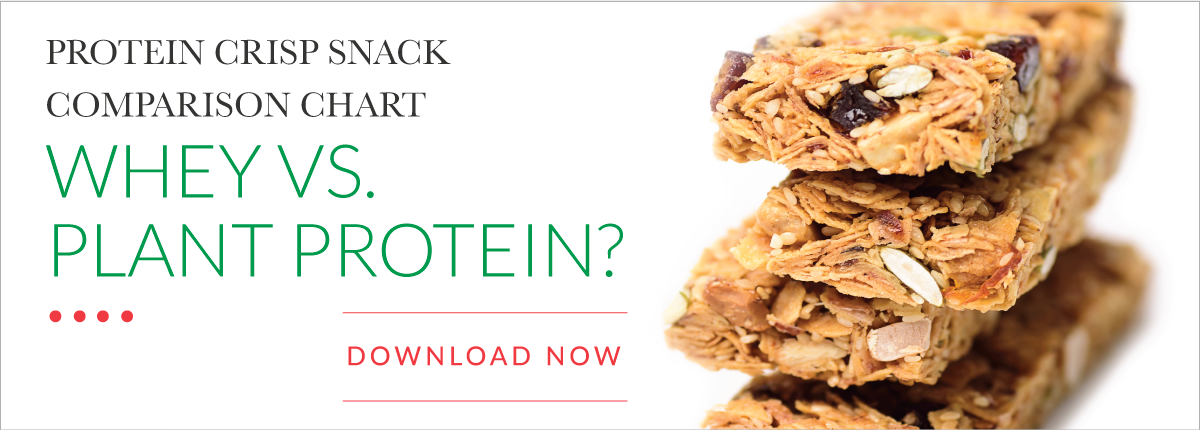
The pace of modern life has redefined “mealtime” for millions of consumers, with many including grab-and-go snack foods as part of or in place of regular meals.
What are they reaching for?
Of course, there are the staples like chips and sweet treats. However, better-for-you snacks like crunchy granola bars and high-protein bars are increasingly among consumer favorites.
Today, we’ll take a look at where the snack industry is today, where it’s going and how makers of snacks can get in on the action with nutritious, clean-label protein crisps in their formulations.
Snack Trends by the Numbers
Before diving in, we gathered data from numerous market research firms and industry leaders to provide a snapshot of the current state of snacking. Bottom line? Americans consume billions of ready-to-eat snack foods each year.
- Nearly every American (90%) snacks at least once a day
- More than one in four (27%) snack multiple times a day
- 31% of consumers reach for better-for-you options like granola bars and high-protein meal replacement bars
- About one-quarter (22%) of consumers’ daily calorie intake is from snacks
- Taste is the most fundamental factor driving snack food selection
- 79% of Americans want healthier snacks with a growing preference for protein-rich snacks
- Crunchy snacks are the top-selling specialty food category with $6.1 billion in annual sales
Whey Protein Crisps vs. Plant Proteins
Crunchy textures and flavorful, protein-rich snacks that are budget-friendly are the go-to preferences of consumers, but formulating an application that hits on all points has been a major challenge.
Plant proteins have certainly surged in recent years, receiving a lot of attention and marketing dollars. Consumers are intrigued by the idea of plant protein and plant protein crisps, but the off flavors and inferior protein quality have been disappointing for many. Consumers are reaching instead for more whey protein and whey protein crisps in their snacking options.
Whey protein is the dominant ingredient in protein bar formulations because it offers superior protein and flavor. What’s more, whey is preferred by consumers according to the latest market share data that shows the whey protein market growing at a faster pace than plant-based proteins.
Global Whey Protein Market Size: Projected to grow from $12.64 billion in 2024 to $22.63 billion by 2032 (7.5% CAGR).
Global Plant-Based Protein Market Size: Projected to grow from $6.26 billion in 2024 to $10.17 billion by 2032 (6.24% CAGR).
When it comes to consumer preferences, whey protein often comes out on top not only for its better nutrition and flavor but also for its texture. A major challenge for plant-based formulations is delivering both. Many like soy or pea proteins provide off-flavors that require masking agents, and the interactions with other ingredients often result in a chalky mouthfeel.
RELATED STUDY: Compare Whey Protein Crisps vs. Plant-Based Crisps
Consumers expect unique, indulgent flavor profiles and crispy textures that aren’t too hard or too soft. Whey protein crisps deliver on all counts. Just some examples of protein-packed foods made with whey protein crisps include:
- Protein bars and bites
- Snack mixes
- Cereals
- Confections
- Wafer snacks
- Cookies and bars
- And more
Formulation Solutions With a Crunch
Whey protein not only requires less processing than plant-based ingredients, it also does a better job of maintaining its structure and has cleaner flavors, resulting in better taste and texture. Formaltors who use whey protein are likely to have a much higher success rate in achieving the desired functionality and flavor they’re looking for.
Whey crisps add a light, crunchy texture that is appealing to consumers and formulators alike. Our Grande WPCrisp®, with its neutral flavor profile, is a great complement to the primary ingredients of your snack formulation with 70% protein content. For those who want to formulate a chocolatey treat, it is available in cocoa flavor. Like all our other protein ingredients, WPCrisp is an ethically sourced, clean-label ingredient that is a familiar favorite and trusted by consumers.
Our expert team of food scientists is here to help you address formulation challenges, improve nutrition and expand your supply chain to include innovative whey ingredients that outperform not only plant-based proteins but other whey proteins on the market. Let us prove it to you. Get in touch.





